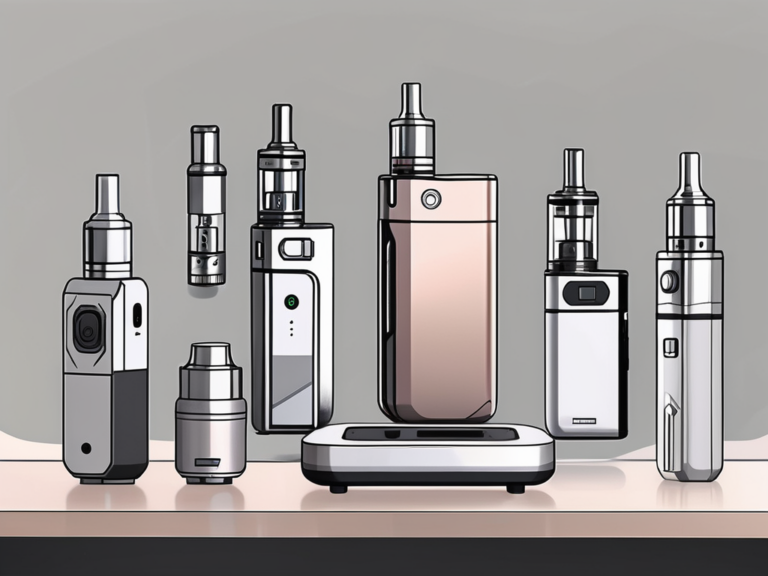who invented vapes
Everyone knows vaping has taken the world by storm, but have you ever wondered about its origins? In this article, we will explore the birth of the vaping revolution and delve into the intriguing history behind it. From the basic components of a vape to the controversies surrounding its impact on society, we will cover it all. So, let’s embark on a journey to discover who invented vapes and how they’ve evolved over the years.
Understanding the Concept of Vaping
Vaping, short for vaporizing, refers to the inhalation of vapor produced by a device called a vape. It has gained popularity as an alternative to traditional smoking, with many people turning to vaping for various reasons. To truly understand vaping, we must first familiarize ourselves with its basic components.
Vaping has become a cultural phenomenon, with a wide range of devices and flavors available to suit different preferences. From sleek, pocket-sized pod vapes to larger, customizable mods, the variety in vaping products allows users to personalize their experience. Additionally, the e-liquids used in vapes come in countless flavors, ranging from classic tobacco and menthol to fruity and dessert-inspired options, catering to diverse tastes.
The Basic Components of a Vape
A vape consists of a few essential components, including a battery, a heating element known as an atomizer, a reservoir for e-liquid, and a mouthpiece. When the user activates the device, the battery heats up the atomizer, vaporizing the e-liquid and allowing it to be inhaled.
The battery in a vape can vary in size and power, influencing factors such as vapor production and battery life. Some vapes feature built-in batteries that are rechargeable, while others use removable batteries that can be swapped out for continuous use. The atomizer plays a crucial role in heating the e-liquid, with different types available, such as coils made of various materials like kanthal, stainless steel, or nickel, each affecting the vaping experience in unique ways.
The Science Behind Vaping
The process of vaporization is achieved through a combination of heat and airflow. The atomizer, powered by the battery, rapidly heats the e-liquid, turning it into vapor. By inhaling this vapor, users can enjoy the flavors and potential benefits without the harmful combustion byproducts found in traditional smoking.
Understanding the science behind vaping involves delving into concepts like Ohm’s law, which relates to the relationship between voltage, current, and resistance in a circuit. This law is relevant to vapers who engage in coil building or use advanced vaping setups to customize their experience. Additionally, airflow control in a vape device affects the draw resistance and temperature of the vapor, allowing users to fine-tune their vaping experience to their liking.
The History of Vaping
The history of vaping dates back to ancient times when our ancestors experimented with different methods of vaporization. However, modern vaping as we know it today emerged in the late 20th century with the invention of the first electronic cigarette.
Early Attempts at Vaporization
Early attempts at vaporization can be traced back to ancient civilizations. The ancient Egyptians, for example, used hot stones to produce inhalable herbal vapors. Similarly, in India, the practice of Ayurveda involved vaporization to deliver herbal remedies.
Around 500 B.C., the Greek historian Herodotus documented how the Scythians, a nomadic tribe, would throw cannabis seeds onto hot stones and inhale the resulting vapor. This early form of vaporization shows that the concept of vaping has been around for centuries, evolving and adapting over time.
Modern Vaping: A Timeline
In the modern era, vaping gained traction in the early 2000s when several inventors began developing electronic cigarettes. These early prototypes laid the foundation for the vaping devices we see today. Let’s take a closer look at the inventor who revolutionized vaping.
Hon Lik, a Chinese pharmacist, is credited with inventing the first modern electronic cigarette in 2003. Motivated by his father’s struggle with smoking-related illness, Lik sought to create a safer alternative to traditional cigarettes. His device used ultrasound technology to vaporize a nicotine solution, providing users with a smoke-free way to satisfy their cravings.
The Inventor of the Modern E-Cigarette
Hon Lik, a Chinese pharmacist, is widely regarded as the inventor of the modern e-cigarette. Inspired by his personal struggle with smoking, Lik aimed to create a safer alternative that could provide nicotine without the harmful effects of combustion.
Hon Lik: The Father of Vaping
In 2003, Hon Lik introduced his groundbreaking device, which used ultrasound technology to create an aerosolized nicotine solution for inhalation. This invention was the catalyst that launched the vaping revolution, forever changing the landscape of smoking cessation.
The Motivation Behind the Invention
Hon Lik’s motivation stemmed from a desire to improve his own health and the well-being of others. By creating a device that simulated smoking without the associated harmful chemicals, he aimed to offer smokers a potentially safer alternative.
It is fascinating to note that Hon Lik’s invention not only revolutionized the smoking industry but also sparked a global debate on the safety and regulation of e-cigarettes. The rapid rise in popularity of vaping raised concerns about its impact on public health, leading to ongoing research and discussions among health professionals and policymakers.
Global Impact and Controversies
As the e-cigarette market continues to expand worldwide, Hon Lik’s contribution has left a lasting impact on society. While many view vaping as a valuable tool for smoking cessation, others raise questions about its long-term effects and potential appeal to younger generations.
The Evolution of Vaping Devices
Since the invention of the modern e-cigarette, vaping devices have undergone significant evolution. From rudimentary designs to sophisticated devices with advanced features, vapes have come a long way in a relatively short span of time.
One of the key driving forces behind the evolution of vaping devices has been the demand for increased customization and functionality. Vapers today have a plethora of options to choose from, ranging from compact pod systems for on-the-go convenience to powerful box mods for enthusiasts who prefer a more customizable vaping experience.
From First Generation to Present
The first-generation e-cigarettes resembled traditional cigarettes in shape and size, utilizing disposable cartridges. As technology advanced, second and third-generation devices introduced refillable tanks and adjustable features. Today, we have fourth-generation devices and beyond, boasting sleek designs, customizable settings, and improved safety features.
Furthermore, the materials used in modern vaping devices have also seen significant improvements. From durable stainless steel and zinc alloy constructions to innovative carbon fiber and resin panels, manufacturers are constantly pushing the boundaries of design and functionality to cater to the diverse preferences of vapers worldwide.
Technological Advancements in Vaping
Technological advancements have propelled vaping devices to new heights. From temperature control and wattage adjustment to the advent of pod systems and automatic draw activation, innovation in vaping technology continues to shape the industry, providing users with a range of options.
In addition to hardware innovations, the e-liquid industry has also seen remarkable growth, with manufacturers experimenting with a myriad of flavors, nicotine strengths, and VG/PG ratios to cater to the evolving tastes of consumers. This focus on flavor diversity and quality has transformed vaping into a sensory experience that goes beyond just nicotine delivery.
The Impact of Vaping on Society
As vaping has gained popularity, it has had a profound impact on society. Let’s explore how the rise of vape culture has influenced trends and examine the controversies and health concerns associated with vaping.
The Rise of Vape Culture
Vape culture has emerged as a distinct subculture, with enthusiasts and communities organizing vape meets, competitions, and sharing their experiences on social media. From cloud-chasing to flavor exploration, the sharing of knowledge and camaraderie has fostered a vibrant vaping community.
Moreover, the rise of vape culture has also led to the development of a wide range of vaping devices and accessories. Vapers can now choose from a plethora of options, including pod systems, box mods, and rebuildable atomizers, allowing for a personalized vaping experience tailored to individual preferences.
Controversies and Health Concerns
While many people view vaping as a potentially safer alternative to smoking, it is not without its controversies and health concerns. The long-term effects of vaping are still being studied, and caution should always be exercised, particularly among non-smokers, young adults, and pregnant individuals.
Furthermore, the marketing tactics employed by some vape companies have come under scrutiny for targeting youth and non-smokers, raising concerns about the normalization of vaping among vulnerable populations. Additionally, the lack of strict regulations in some regions has led to the proliferation of counterfeit vaping products, posing potential risks to consumers.
In conclusion, vaping has come a long way since its ancient origins. Hon Lik’s innovative spirit revolutionized the smoking industry, offering smokers an alternative that has now become a cultural phenomenon. As vaping technology continues to evolve, it is crucial for users to stay informed about the potential benefits and risks associated with this popular trend.






